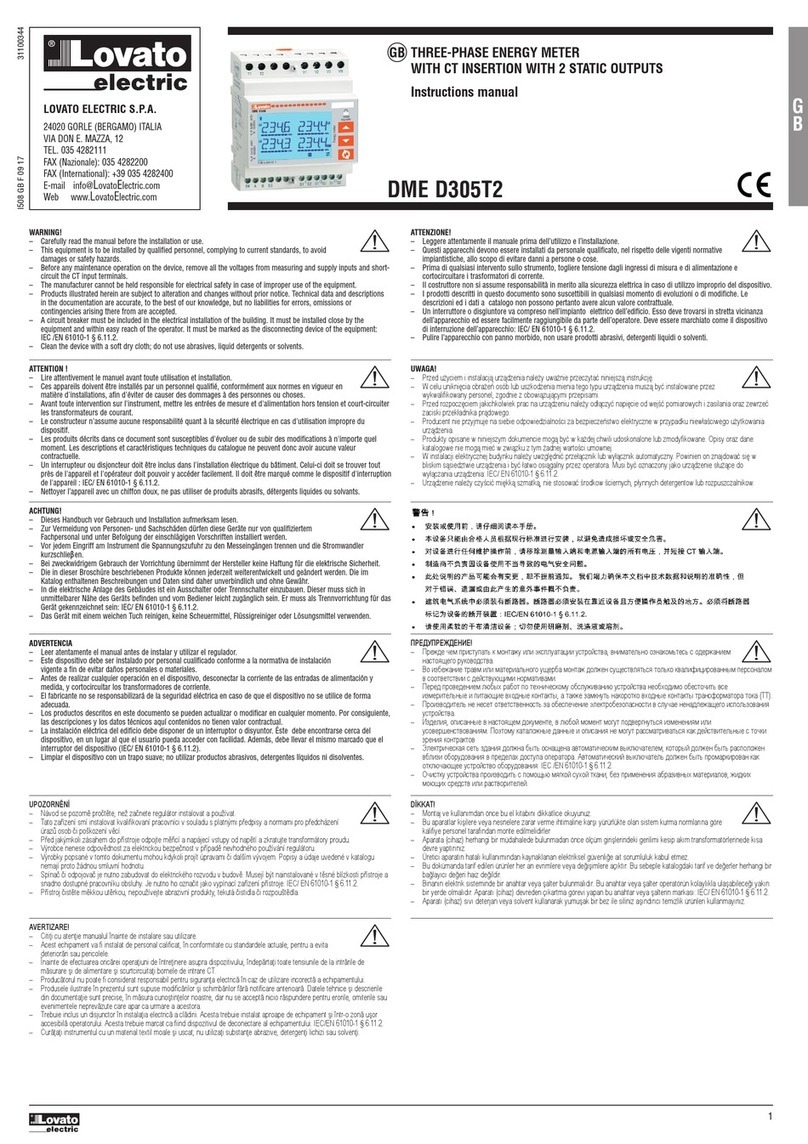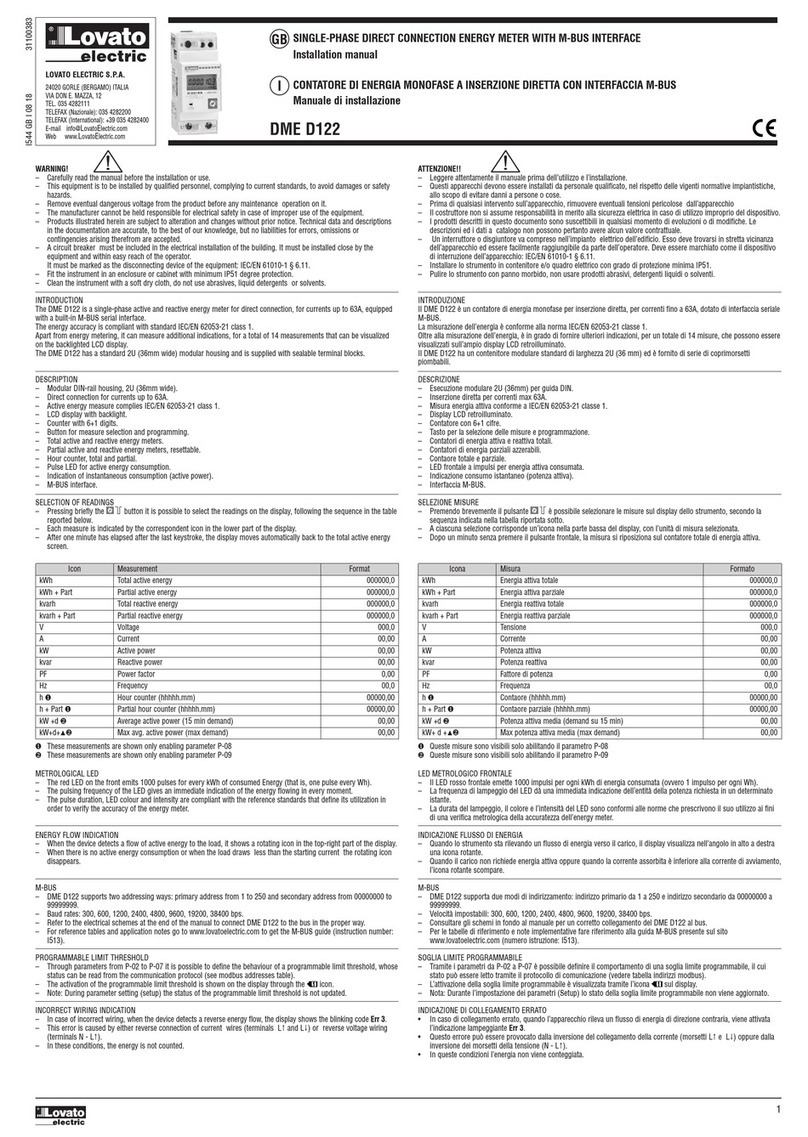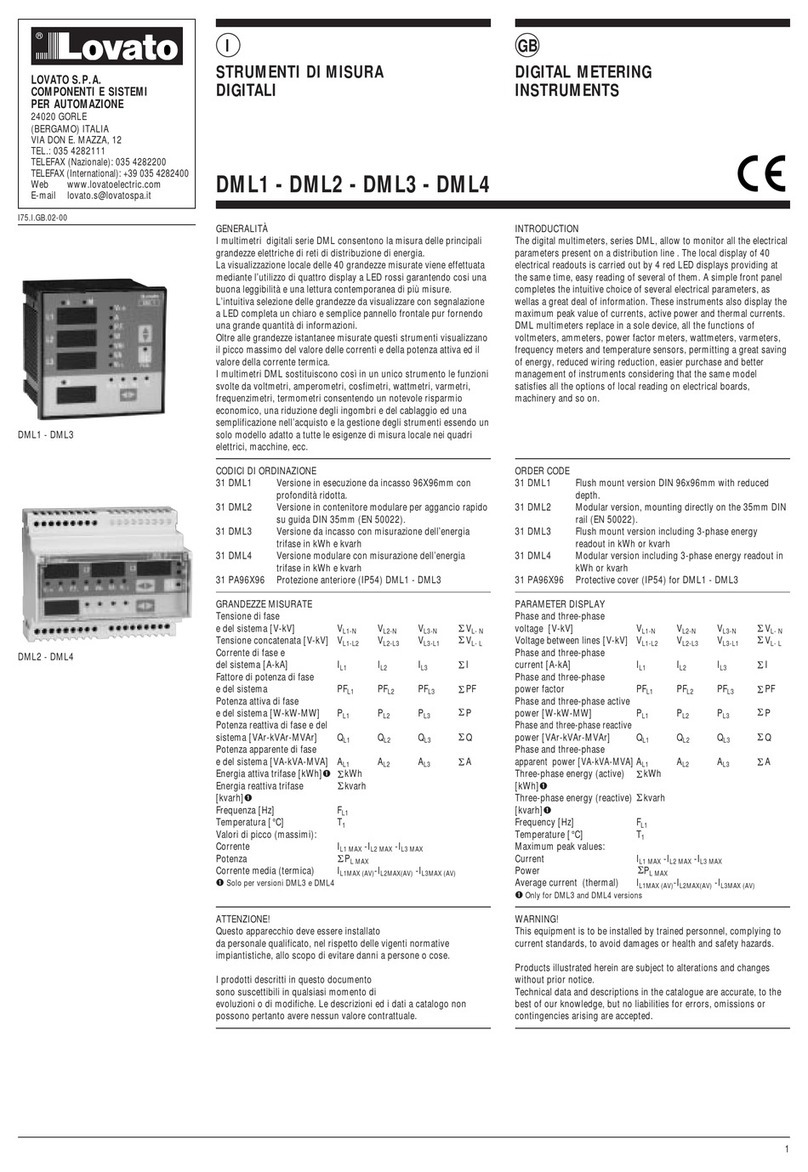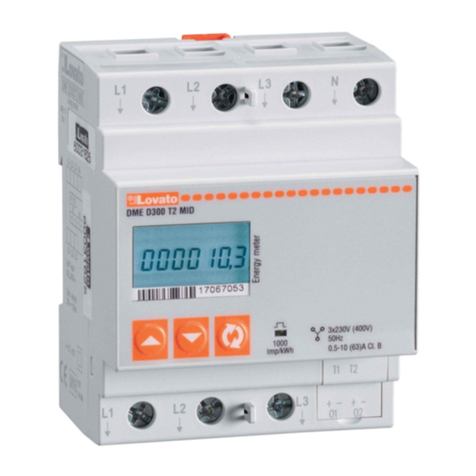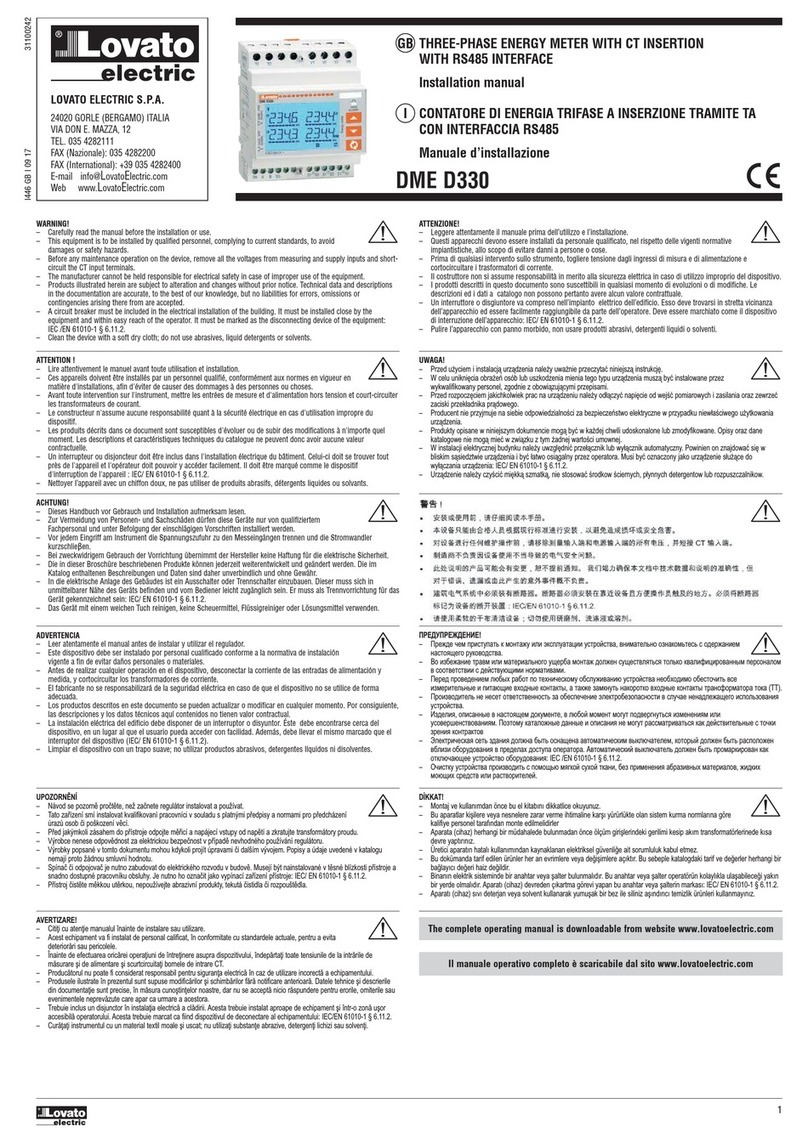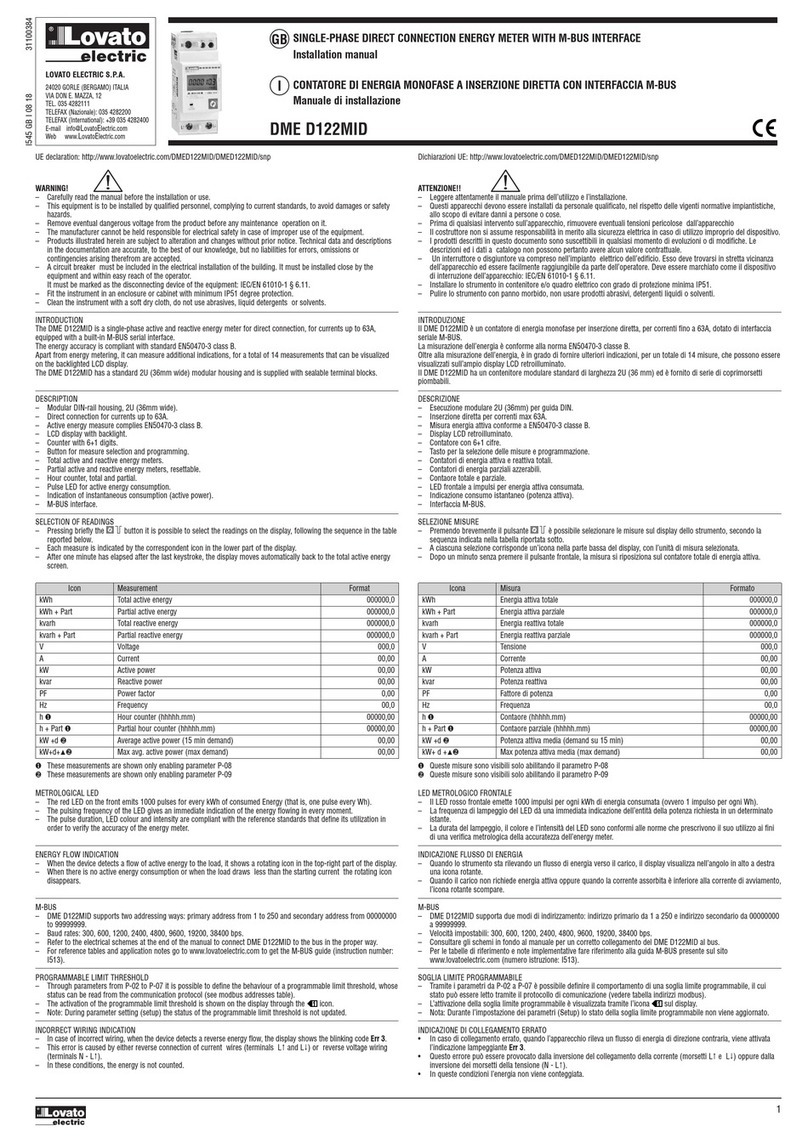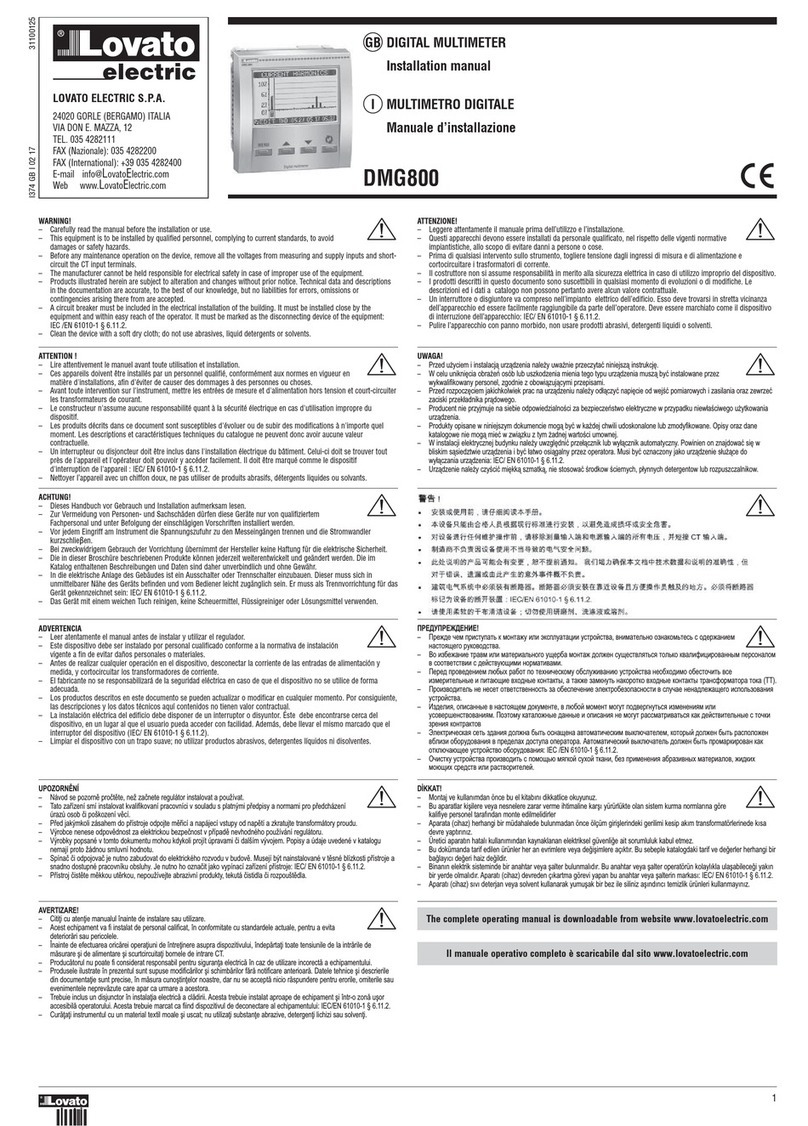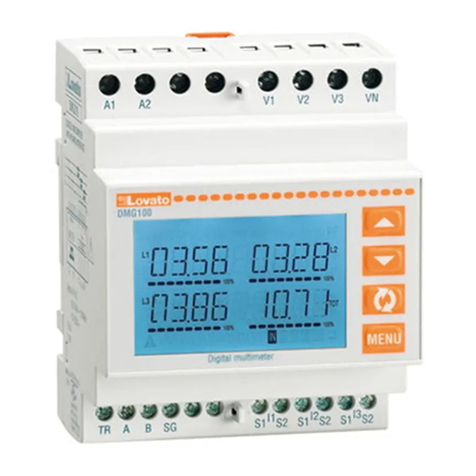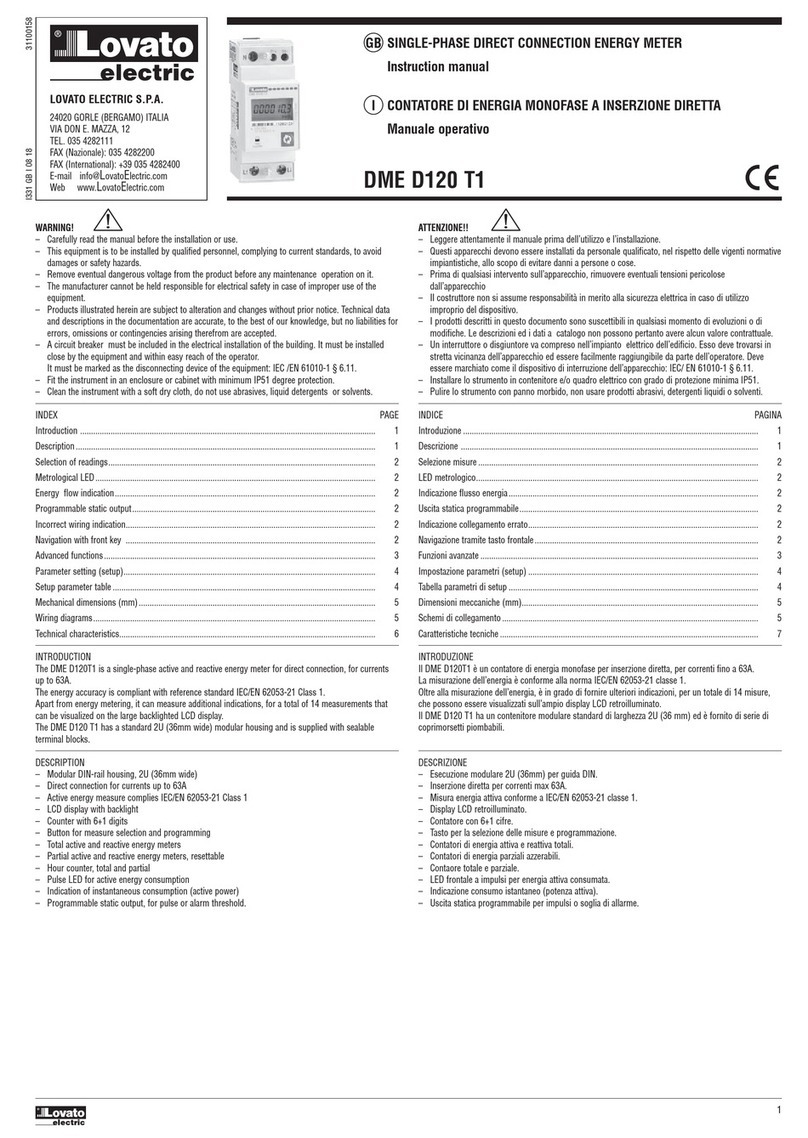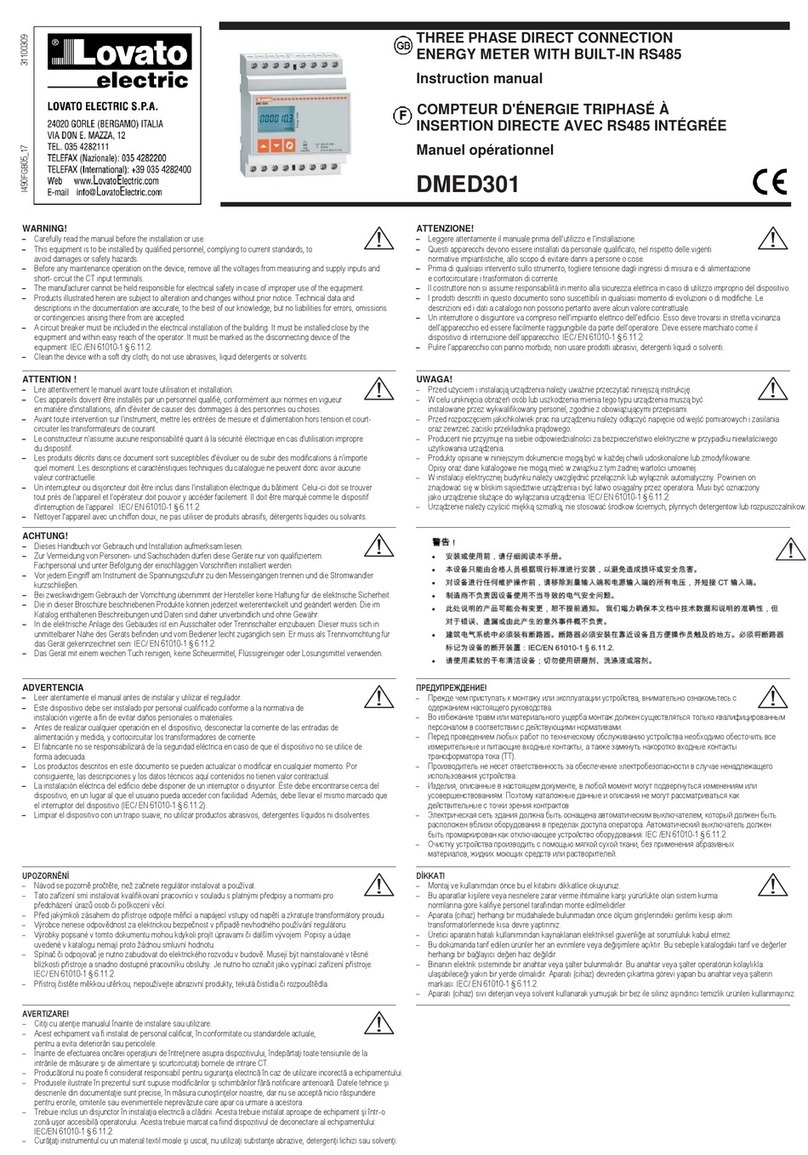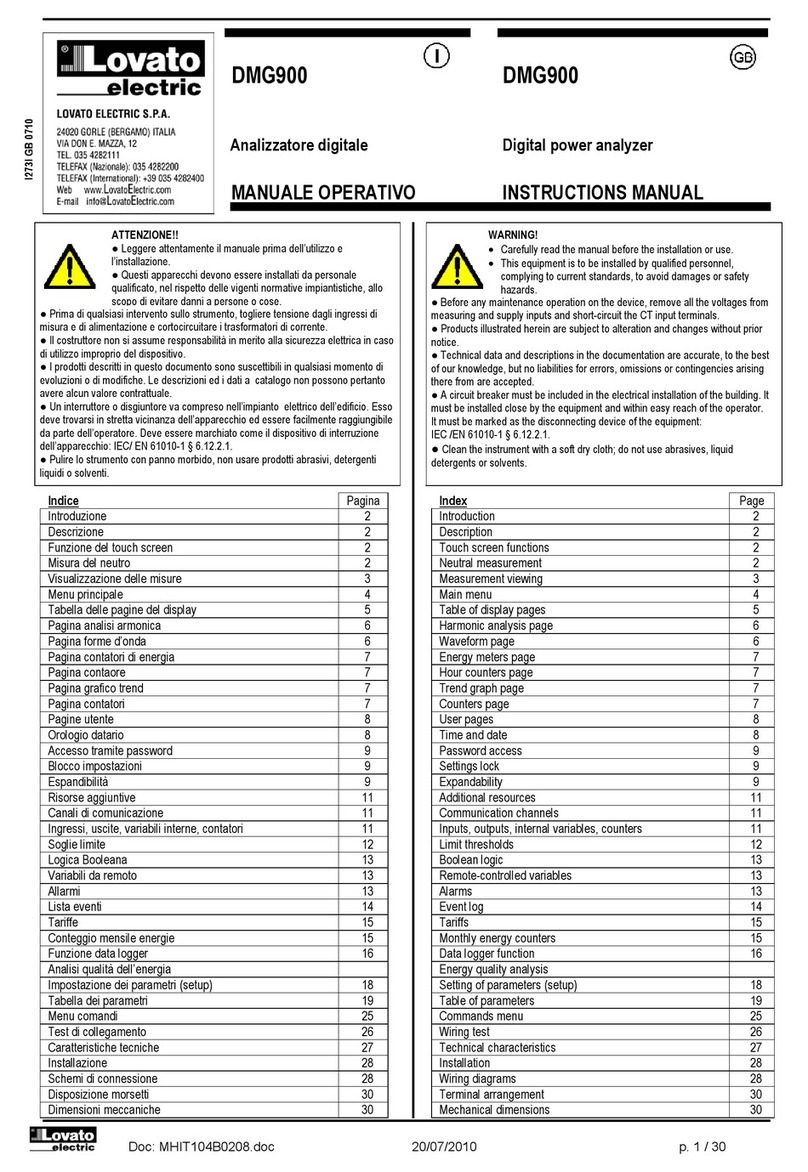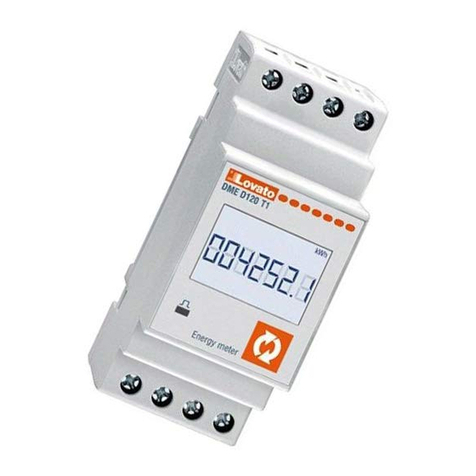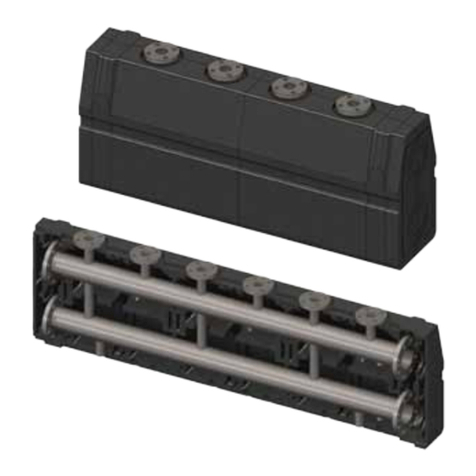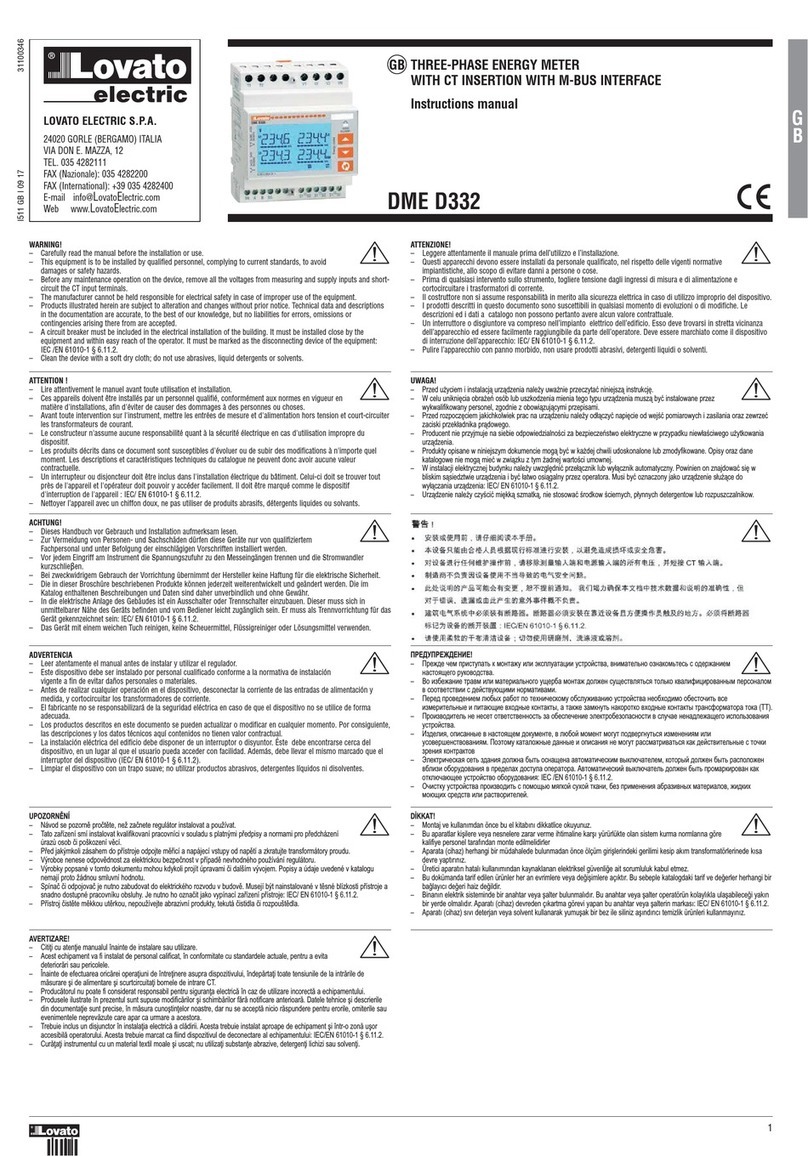
WARNING!
Carefully read the manual before the installation or use.
This equipment is to be installed by qualified personnel, complying to current standards, to
avoid damages or safety hazards.
Before any maintenance operation on the device, remove all the voltages from measuring and supply inputs and
short- circuit the CT input terminals.
The manufacturer cannot be held responsible for electrical safety in case of improper use of the equipment.
Products illustrated herein are subject to alteration and changes without prior notice. Technical data and
descriptions in the documentation are accurate, to the best of our knowledge, but no liabilities for errors, omissions
or contingencies arising there from are accepted.
A circuit breaker must be included in the electrical installation of the building. It must be installed close by the
equipment and within easy reach of the operator. It must be marked as the disconnecting device of the
equipment: IEC /EN 61010-1 § 6.11.3.1
Clean the device with a soft dry cloth; do not use abrasives, liquid detergents or solvents.
ATTENZIONE!
Leggere attentamente il manuale prima dell’utilizzo e l’installazione.
Questi apparecchi devono essere installati da personale qualificato, nel rispetto delle vigenti
normative impiantistiche, allo scopo di evitare danni a persone o cose.
Prima di qualsiasi intervento sullo strumento, togliere tensione dagli ingressi di misura e di alimentazione
e cortocircuitare i trasformatori di corrente.
Il costruttore non si assume responsabilità in merito alla sicurezza elettrica in caso di utilizzo improprio del dispositivo.
I prodotti descritti in questo documento sono suscettibili in qualsiasi momento di evoluzioni o di modifiche. Le
descrizioni ed i dati a catalogo non possono pertanto avere alcun valore contrattuale.
Un interruttore o disgiuntore va compreso nell’impianto elettrico dell’edificio. Esso deve trovarsi in stretta vicinanza
dell’apparecchio ed essere facilmente raggiungibile da parte dell’operatore. Deve essere marchiato come il
dispositivo di interruzione dell’apparecchio: IEC/ EN 61010-1 § 6.11.3.1.
Pulire l’apparecchio con panno morbido, non usare prodotti abrasivi, detergenti liquidi o solventi.
ATTENTION!
Lire attentivement le manuel avant toute utilisation et installation.
Ces appareils doivent être installés par un personnel qualifié, conformément aux normes en vigueur
en matière d'installations, afin d'éviter de causer des dommages à des personnes ou choses.
Avant toute intervention sur l'instrument, mettre les entrées de mesure et d'alimentation hors tension et court-
circuiter les transformateurs de courant.
Le constructeur n'assume aucune responsabilité quant à la sécurité électrique en cas d'utilisation impropre
du dispositif.
Les produits décrits dans ce document sont susceptibles d'évoluer ou de subir des modifications à n'importe
quel moment. Les descriptions et caractéristiques techniques du catalogue ne peuvent donc avoir aucune
valeur contractuelle.
Un interrupteur ou disjoncteur doit être inclus dans l'installation électrique du bâtiment. Celui-ci doit se trouver
tout près de l'appareil et l'opérateur doit pouvoir y accéder facilement. Il doit être marqué comme le dispositif
d'interruption de l'appareil : IEC/ EN 61010-1 § 6.11.3.1.
Nettoyer l’appareil avec un chiffon doux, ne pas utiliser de produits abrasifs, détergents liquides ou solvants.
ACHTUNG!
Dieses Handbuch vor Gebrauch und Installation aufmerksam lesen.
Zur Vermeidung von Personen- und Sachschäden dürfen diese Geräte nur von qualifiziertem
Fachpersonal und unter Befolgung der einschlägigen Vorschriften installiert werden.
UWAGA!
Przed u<yciem i instalacj.urz.dzenia nale<y uwa<nie przeczyta*niniejsz.instrukcj0.
W celu unikni0cia obra<e3osób lub uszkodzenia mienia tego typu urz.dzenia musz.by*
instalowane przez wykwalifikowany personel, zgodnie z obowi.zuj.cymi przepisami.
Przed rozpocz0ciem jakichkolwiek prac na urz.dzeniu nale<y od#.czy*napi0cie od wej6* pomiarowych i
zasilania oraz zewrze*zaciski przek#adnika pr.dowego.
Producent nie przyjmuje na siebie odpowiedzialno6ci za bezpiecze3stwo elektryczne w przypadku
niew#a6ciwego u<ytkowania urz.dzenia.
Produkty opisane w niniejszym dokumencie mog.by*w ka<dej chwili udoskonalone lub zmodyfikowane.
Opisy oraz dane katalogowe nie mog.mie*w zwi.zku z tym <adnej warto6ci umownej.
W instalacji elektrycznej budynku nale<y uwzgl0dni*prze#.cznik lub wy#.cznik automatyczny. Powinien on
znajdowa*si0w bliskim s.siedztwie urz.dzenia i by*#atwo osi.galny przez operatora. Musi by*oznaczony jako
urz.dzenie s#u<.ce do wy#.czania urz.dzenia: IEC/ EN 61010-1 § 6.11.3.1.
Urz.dzenie nale<y czy6ci*mi0kk.szmatk., nie stosowa*6rodkow 6ciernych, p#ynnych detergentow lub rozpuszczalnikow.
Vor jedem Eingriff am Instrument die Spannungszufuhr zu den Messeingängen trennen und die Stromwandler
kurzschlieBen.
Bei zweckwidrigem Gebrauch der Vorrichtung übernimmt der Hersteller keine Haftung für die elektrische Sicherheit.
Die in dieser Broschüre beschriebenen Produkte können jederzeit weiterentwickelt und geändert werden. Die im
Katalog enthaltenen Beschreibungen und Daten sind daher unverbindlich und ohne Gewähr.
In die elektrische Anlage des Gebäudes ist ein Ausschalter oder Trennschalter einzubauen. Dieser muss sich in
unmittelbarer Nähe des Geräts befinden und vom Bediener leicht zugänglich sein. Er muss als Trennvorrichtung für
das Gerät gekennzeichnet sein: IEC/ EN 61010-1 § 6.11.3.1.
Das Gerät mit einem weichen Tuch reinigen, keine Scheuermittel, Flüssigreiniger oder Lösungsmittel verwenden.
ADVERTENCIA
Leer atentamente el manual antes de instalar y utilizar el regulador.
Este dispositivo debe ser instalado por personal cualificado conforme a la normativa de
instalación vigente a fin de evitar daños personales o materiales.
Antes de realizar cualquier operación en el dispositivo, desconectar la corriente de las entradas de
alimentación y medida, y cortocircuitar los transformadores de corriente.
El fabricante no se responsabilizará de la seguridad eléctrica en caso de que el dispositivo no se utilice de
forma adecuada.
Los productos descritos en este documento se pueden actualizar o modificar en cualquier momento. Por
consiguiente, las descripciones y los datos técnicos aquí contenidos no tienen valor contractual.
La instalación eléctrica del edificio debe disponer de un interruptor o disyuntor. Éste debe encontrarse cerca del
dispositivo, en un lugar al que el usuario pueda acceder con facilidad. Además, debe llevar el mismo marcado que
el interruptor del dispositivo (IEC/ EN 61010-1 § 6.11.3.1).
Limpiar el dispositivo con un trapo suave; no utilizar productos abrasivos, detergentes líquidos ni disolventes.
UPOZORNNÍ
Návod se pozorn1pro+t1te, nežza+nete regulátor instalovat a používat.
Tato za4ízení smí instalovat kvalifikovaní pracovníci v souladu s platnými p4edpisy a normami
pro p4edcházení úraz8osob +i poškození v1cí.
P4ed jakýmkoli zásahem do p4ístroje odpojte m14icí a napájecí vstupy od nap1tí a zkratujte transformátory proudu.
Výrobce nenese odpov1dnost za elektrickou bezpe+nost v p4ípad1nevhodného používání regulátoru.
Výrobky popsané v tomto dokumentu mohou kdykoli projít úpravami +i dalším vývojem. Popisy a údaje uvedené v
katalogu nemají proto žádnou smluvní hodnotu.
Spína++i odpojova+je nutno zabudovat do elektrického rozvodu v budov1. Musejí být nainstalované v t1sné
blízkosti p4ístroje a snadno dostupné pracovníku obsluhy. Je nutno ho ozna+it jako vypínací za4ízení p4ístroje:
IEC/ EN 61010-1 § 6.11.3.1.
P4ístroj +ist1te m1kkou ut1rkou, nepoužívejte abrazivní produkty, tekutá +istidla +i rozpoušt1dla.
AVERTIZARE!
Citi7i cu aten7ie manualul înainte de instalare sau utilizare.
Acest echipament va fi instalat de personal calificat, în conformitate cu standardele actuale,
pentru a evita deterior,ri sau pericolele.
Înainte de efectuarea oric,rei opera7iuni de între7inere asupra dispozitivului, îndep,rta7i toate tensiunile de la intr,rile
de m,surare (i de alimentare (i scurtcircuita7i bornele de intrare CT.
Produc,torul nu poate fi considerat responsabil pentru siguran7a electric,în caz de utilizare incorect,a
echipamentului.
Produsele ilustrate în prezentul sunt supuse modific,rilor (i schimb,rilor f,r,notificare anterioar,. Datele tehnice
(i descrierile din documenta7ie sunt precise, în m,sura cuno(tin7elor noastre, dar nu se accept,nicio r,spundere
pentru erorile, omiterile sau evenimentele neprev,zute care apar ca urmare a acestora.
Trebuie inclus un disjunctor în instala7ia electric,a cl,dirii. Acesta trebuie instalat aproape de echipament (i
într-o zon,u(or accesibil,operatorului. Acesta trebuie marcat ca fiind dispozitivul de deconectare al
echipamentului: IEC/EN 61010-1 § 6.11.3.1.
Cur,7a7i instrumentul cu un material textil moale (i uscat; nu utiliza7i substan7e abrazive, detergen7i lichizi sau
solven7i.
#$%#$ "!!
GZOPNO aOV YZR[\]YJ\e T VXW\JP] RUR fT[YU]J\J`RR ][\ZXS[\LJ, LWRVJ\OUeWX XQWJTXVe\O[e [
XNOZPJWROV WJ[\XhcOMX Z]TXLXN[\LJ.
DX RQKOPJWRO \ZJLV RUR VJ\OZRJUeWXMX ]cOZKJ VXW\JP NXUPOW []cO[\LUh\e[h \XUeTX TLJUR^R`RZXLJWWdV
YOZ[XWJUXV L [XX\LO\[\LRR [ NOS[\L]gcRVR WXZVJ\RLJVR.
GOZON YZXLONOWROV UgKd_ ZJKX\ YX \O_WRaO[TXV] XK[U]PRLJWRg ][\ZXS[\LJ WOXK_XNRVX XKO[\XaR\e L[O
RQVOZR\OUeWdO R YR\JgcRO L_XNWdO TXW\JT\d, J \JTPO QJVTW]\e WJTXZX\TX L_XNWdO TXW\JT\d
\ZJW[^XZVJ\XZJ \XTJ (HH).
GZXRQLXNR\OUe WO WO[O\ X\LO\[\LOWWX[\e QJ XKO[YOaOWRO fUOT\ZXKOQXYJ[WX[\R L [U]aJO WOWJNUOPJcOMX
R[YXUeQXLJWRh ][\ZXS[\LJ.
EQNOURh, XYR[JWWdO L WJ[\XhcOV NXT]VOW\O, L UgKXS VXVOW\ VXM]\ YXNLOZMW]\e[h RQVOWOWRhV RUR
][XLOZbOW[\LXLJWRhV. GXf\XV] TJ\JUXPWdO NJWWdO R XYR[JWRh WO VXM]\ ZJ[[VJ\ZRLJ\e[h TJT
NOS[\LR\OUeWdO [ \XaTR QZOWRh TXW\ZJT\XL
IUOT\ZRaO[TJh [O\e QNJWRh NXUPWJ Kd\e X[WJcOWJ JL\XVJ\RaO[TRV LdTUgaJ\OUOV, TX\XZdS NXUPOW Kd\e
ZJ[YXUXPOW LKURQR XKXZ]NXLJWRh L YZONOUJ_ NX[\]YJ XYOZJ\XZJ. CL\XVJ\RaO[TRS LdTUgaJ\OUe NXUPOW
Kd\e YZXVJZTRZXLJW TJT X\TUgaJgcOO ][\ZXS[\LX XKXZ]NXLJWRh: IEC /EN 61010-1 § 6.11.3.1.
FaR[\T] ][\ZXS[\LJ YZXRQLXNR\e [ YXVXceg VhMTXS []_XS \TJWR, KOQ YZRVOWOWRh JKZJQRLWd_
VJ\OZRJUXL, PRNTR_ VXgcR_ [ZON[\L RUR ZJ[\LXZR\OUOS.
DKKAT!
Montaj ve kullanımdan önce bu el kitabınıdikkatlice okuyunuz.
Bu aparatlar ki(ilere veya nesnelere zarar verme ihtimaline kar(ıyürürlükte olan sistem kurma
normlarına göre kalifiye personel tarafından monte edilmelidirler
Aparata (cihaz) herhangi bir müdahalede bulunmadan önce ölçüm giri(lerindeki gerilimi kesip akım
transformatörlerinede kısa devre yaptırınız.
Üretici aparatın hatalıkullanımından kaynaklanan elektriksel güvenli'e ait sorumluluk kabul etmez.
Bu dokümanda tarif edilen ürünler her an evrimlere veya de'i(imlere açıktır. Bu sebeple katalogdaki tarif ve
de'erler herhangi bir ba'layıcıde'eri haiz de'ildir.
Binanın elektrik sisteminde bir anahtar veya (alter bulunmalıdır. Bu anahtar veya (alter operatörün kolaylıkla
ula(abilece'i yakın bir yerde olmalıdır. Aparatı(cihaz) devreden çıkartma görevi yapan bu anahtar veya (alterin
markası: IEC/ EN 61010-1 § 6.11.3.1.
Aparatı(cihaz) sıvıdeterjan veya solvent kullanarak yumu(ak bir bez ile siliniz a(ındırıcıtemizlik ürünleri kullanmayınız
POWER ANALYZERS
Instruction manual
ANALIZATORY PARAMETRÓW SIECI
Instrukcja obsugi
DMG7000-7500-8000-9000
